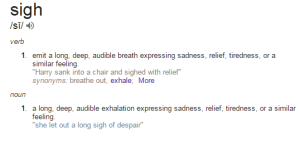 “Sigh” is a favorite instruction of mine. We all need to relax a little, if not a lot. I think many people might think of sighing in a sad sack/Eeyore kind of way but I see it as a positive way to release. As a people we are stuck in a state of heightened tension. Some more than others—but stuck nonetheless.
“Sigh” is a favorite instruction of mine. We all need to relax a little, if not a lot. I think many people might think of sighing in a sad sack/Eeyore kind of way but I see it as a positive way to release. As a people we are stuck in a state of heightened tension. Some more than others—but stuck nonetheless.
It is not healthy to sigh too much or even a lot. There are positive reasons for sighing—some studies say it acts to reset out breathing patterns, others say that sighs are used as signals of a change in plans or a new initiative. And most everybody should have a memory of someone sighing as an emotional response like a rolling of the eyes. On the negative side excessive sighing is intimately related to panic attacks. I use sighing as a simple instruction to relax the breath and the rib cage, hopefully freeing up the diaphragm, the main muscle of breathing, to work a little better.
Fear and our response to fear dominate our lives more than most people realize, and can have a profound effect on our ability to breathe. Helping people to breathe better through greater access to diaphragm is at the heart of what I am trying to accomplish—most people that I encounter don’t breathe fully. While the inability to deep fully might be connected to our fear response in an emotional way, it is the manifestations of the fear response that change our musculature creating the respiratory difficulties.
Because of tight lower back muscles that pull the upper spine backwards the diaphragm gets stuck on the spine and can’t lower down to draw in the breath.
This muscular pattern that I see in so many clients and people in general is the direct result of the individual being stuck in the fear response or sympathetic nervous system.
I remember an afternoon in Central Park when I was around fifteen—I was sitting with a rather intense friend enjoying the passions of youthful thinking when he bore his eyes deeply into mine. “Fear is everything. Everything is fear.”
He was right.
***
